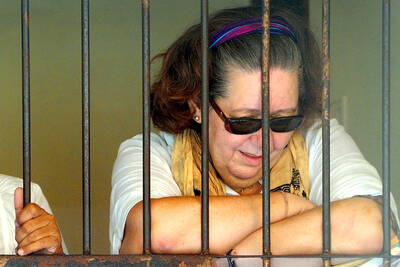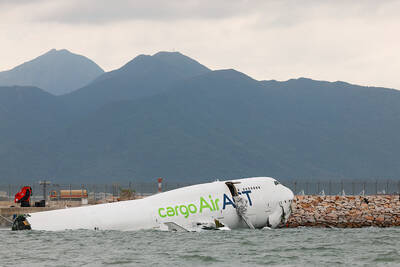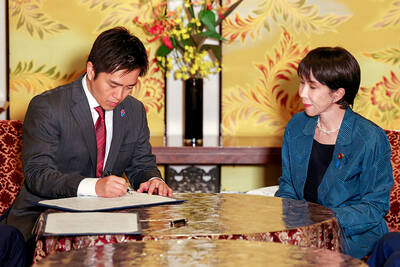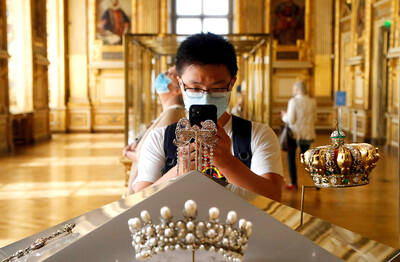Journalists are facing raids and terrorism charges in Ethiopia as the media denounces a renewed “climate of fear” ahead of elections next year. There had been hopes for greater press freedom after Ethiopian Prime Minister Abiy Ahmed took power in 2018, with exiled journalists encouraged to return.
However, a brutal war in the Tigray region from 2020 to 2022, and ongoing insurgencies in the Amhara and Oromia regions have led to those freedoms being once again harshly curtailed.
Last month, three employees of Addis Standard, an online newspaper, were detained for several hours for unknown reasons following a police raid on their offices. Six laptops and eight phones were seized and have still not been returned.

Photo: Reuters
In March, seven journalists from the private Ethiopian Broadcasting Service were arrested in a terrorism investigation after the broadcast of a documentary in which a woman claimed to have been raped by men in military uniform. The woman later retracted her statements and the station apologized, but that was not accepted by the authorities.
On April 23, a journalist for The Reporter newspaper, who was investigating the grievances of dismissed former military personnel seeking financial compensation, was arrested.
Last month also saw parliament pass an amendment to the press freedom law, putting oversight powers in the hands of the prime minister’s office rather than the semi-independent media association.
“The current situation for journalists in Ethiopia is more dire than ever,” said Tesfa, a journalist who has worked in the east African country for 10 years. Like other journalists interviewed by AFP, he gave a false name for fear of repercussions by the security agencies, describing a widespread “climate of fear”.
After the Addis Standard raid, Admasu, who works for a private media outlet, said he deleted messages on WhatsApp and social media.
“I realized it was time to think twice before doing anything that might land me in jail for no reason,” he said.
On Saturday last week, World Press Freedom Day, 14 diplomatic missions in Ethiopia, including the UK, Belgium and France, issued a statement deploring the fact that “freedom of expression continues to be subject to significant pressure.”
Some of the toughest restrictions are around access to Oromia and Amhara, the insurgency-hit regions that are Ethiopia’s most populous, with more than 60 million people between them.
Millions of children are deprived of schooling, and hundreds of thousands of people have been displaced by the violence, but reporters are rarely granted access.
France-based media watchdog Reporters Without Borders (RSF) put Ethiopia 145th out of 180 countries in its latest press freedom ranking.
Abiy, who won the Nobel Peace Prize in 2019 for his temporary rapprochement with neighboring Eritrea, had opened up the media space for a while, it said.
Ethiopia was “more open and pluralistic than under the previous regime, and more than 200 once-banned media outlets are now authorized,” it added, but the government was now moving to “retake control of the information space.”
Sadibou Marong, director of RSF’s sub-Saharan Africa bureau, said the “recent attacks on press freedom... are weakening an already precarious situation”, with journalists facing “long detentions” and being forced into self-censorship.
Local reporters fear the situation would only get worse.

Indonesia was to sign an agreement to repatriate two British nationals, including a grandmother languishing on death row for drug-related crimes, an Indonesian government source said yesterday. “The practical arrangement will be signed today. The transfer will be done immediately after the technical side of the transfer is agreed,” the source said, identifying Lindsay Sandiford and 35-year-old Shahab Shahabadi as the people being transferred. Sandiford, a grandmother, was sentenced to death on the island of Bali in 2013 after she was convicted of trafficking drugs. Customs officers found cocaine worth an estimated US$2.14 million hidden in a false bottom in Sandiford’s suitcase when

CAUSE UNKNOWN: Weather and runway conditions were suitable for flight operations at the time of the accident, and no distress signal was sent, authorities said A cargo aircraft skidded off the runway into the sea at Hong Kong International Airport early yesterday, killing two ground crew in a patrol car, in one of the worst accidents in the airport’s 27-year history. The incident occurred at about 3:50am, when the plane is suspected to have lost control upon landing, veering off the runway and crashing through a fence, the Airport Authority Hong Kong said. The jet hit a security patrol car on the perimeter road outside the runway zone, which then fell into the water, it said in a statement. The four crew members on the plane, which

Japan’s ruling Liberal Democratic Party (LDP) and its junior partner yesterday signed a coalition deal, paving the way for Sanae Takaichi to become the nation’s first female prime minister. The 11th-hour agreement with the Japan Innovation Party (JIP) came just a day before the lower house was due to vote on Takaichi’s appointment as the fifth prime minister in as many years. If she wins, she will take office the same day. “I’m very much looking forward to working with you on efforts to make Japan’s economy stronger, and to reshape Japan as a country that can be responsible for future generations,”

SEVEN-MINUTE HEIST: The masked thieves stole nine pieces of 19th-century jewelry, including a crown, which they dropped and damaged as they made their escape The hunt was on yesterday for the band of thieves who stole eight priceless royal pieces of jewelry from the Louvre Museum in the heart of Paris in broad daylight. Officials said a team of 60 investigators was working on the theory that the raid was planned and executed by an organized crime group. The heist reignited a row over a lack of security in France’s museums, with French Minister of Justice yesterday admitting to security flaws in protecting the Louvre. “What is certain is that we have failed, since people were able to park a furniture hoist in the middle of